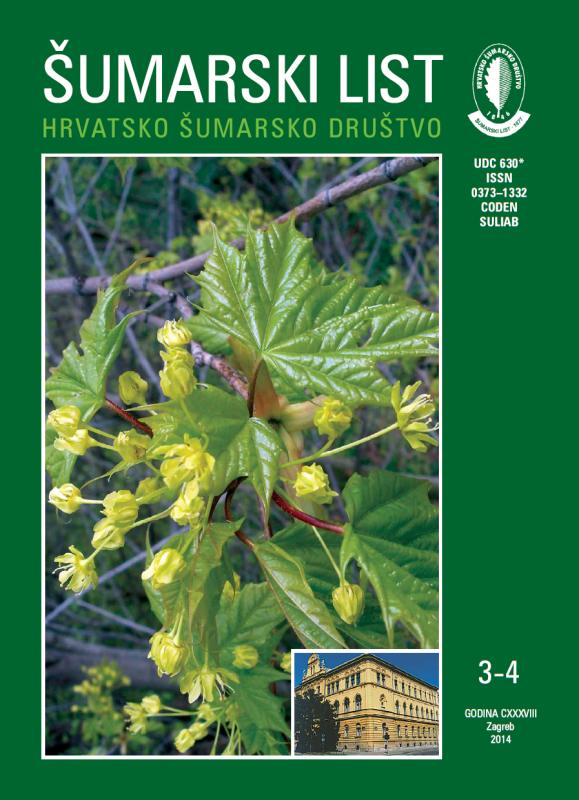
broj: 3-4/2014
pdf (8,09 MB) |
|
||||||||||||||
| RIJEČ UREDNIŠTVA | ||
| Uredništvo | ||
| THE STATUS AND POSSIBILITIES OF A MORE ACCURATE EVALUATION OF FORESTS AND FORESTRY AS PART OF THE ECONOMY OF THE REPUBLIC OF CROATIA pdf HR EN | 121 | |
| IZVORNI ZNANSTVENI ČLANCI | ||
| Jura ČAVLOVIĆ, Krunoslav TESLAK, Karlo BELJAN | UDK 630*569+653+231 (001) | |
| THE EFFECTS OF DIFFERENT STAND REGENERATION PLANNING ON MANAGEMENT AND PEDUNCULATE OAK FOREST DEVELOPMENT – A SMALL SIZE MANAGEMENT CLASS CASE STUDY pdf HR EN | 123 | |
| Dalibor Ballian, Alma Hajrudinović, Jozo Franjić, Faruk Bogunić | UDK 630*164 (Quercus trojana Webb.) (001) | |
| MORPHOLOGICAL VARIABILITY OF THE LEAVES OF THE MACEDONIAN OAK Quercus trojana WEBB.) IN BOSNIA AND HERZEGOVINA AND MONTENEGRO pdf HR EN | 135 | |
| Summary A morphometric analysis of the leaf traits of Macedonian Oak (Q. trojana) in its north-westernmost range was conducted, including in total 130 individuals from 13 natural populations in Bosnia and Herzegovina and Montenegro. The purpose of the study was to use the analysis of variance for the morphological characteristics of leaves from small and markedly fragmented populations to determine if there are any patterns of population differentiation and detect the morphological characteristics associated with such differentiation. The Principal Components Analysis (PCA) did not identify the existence of discrete groups but rather of a continuous gradient in the variation of morphological characteristics and the absence of geographical population patterns. The morphological characteristics most closely related to population differences displayed relatively low to moderate values with PCs whose maximum correlation values were ≤ 0.554. The results of a cluster analysis conformed to the PCA results, indicating two population groups, which equally display no geographical pattern. The results of descriptive and univariate statistics pointed to marked variability of morphological leaf characteristic between populations and the presence of significant differences among individuals. Finally, it should be noted that the study of populations of Macedonian Oak in its north-westernmost range identified a high degree of variability in the morphological leaf characteristics studied, and indicate that many different factors impact on the patterns of the small and fragmented populations of this species in Bosnia and Herzegovina and Montenegro. Further research on a larger sample, using molecular markers, will contribute to a better and more accurate knowledge of Macedonian Oak variability in this part of its natural range. Since this is a sub-Mediterranean region, and Macedonian Oak is a very important tree species from ecological point of view, thus conservation by in situ method in all open and preserved areas is recommended, with particular attention to the origin of the forest reproductive material for reintroduction to degraded habitats, as suggested by the results obtained. Key words: Quercus trojana; leaf morphology; inter- and intrapopulation variability. | ||
| Krunoslav Arač, Milan Pernek | UDK 630*453 (001) | |
| OCCURRENCE AND SPREADING OF THE LARGE LARCH BARK BEETLE (Ips cembrae) IN CROATIA AND POSSIBLITIES OF MONITORING BY USING PHEROMONE TRAPS pdf HR EN | 145 | |
| Maja Popović, Mladen Ivanković, Saša Bogdan | UDK 630* 165 + 181.8 (001) | |
| VARIABILITY OF HEIGHT GROWTH AND SURVIVAL OF PROGENIES FROM PEDUNCULATE OAK (Quercus robur L.) SEED STANDS AT THE FIELD TRIAL ‘JASTREBARSKI LUGOVI’ – FIRST RESULTS pdf HR EN | 155 | |
| Ivana Vitasović Kosić, Mihaela Britvec | UDK 630*187 + 268 (001) | |
| FLORISTIC AND VEGETATION CHARACTERISTIC OF FOREST EDGES AND GRASSLANDS OF ĆIĆARIJA (CROATIA) pdf HR EN | 167 | |
| PRETHODNO PRIOPĆENJE | ||
| Manana Kereselidze, Slavimira Draganova, Daniela Pilarska, Andreas Linde | UDK 630*453 | |
| SUSCEPTIBILITY OF Lymantria monacha AND L. dispar TO THE ENTOMOPATHOGENIC FUNGUS Isaria fumosorosea WIZE pdf HR EN | 185 | |


